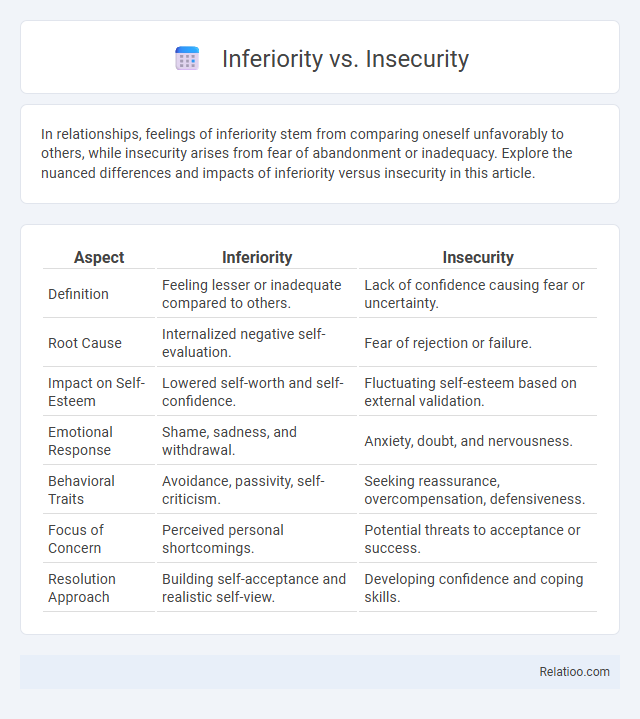In relationships, feelings of inferiority stem from comparing oneself unfavorably to others, while insecurity arises from fear of abandonment or inadequacy. Explore the nuanced differences and impacts of inferiority versus insecurity in this article.
Table of Comparison
| Aspect | Inferiority | Insecurity |
|---|---|---|
| Definition | Feeling lesser or inadequate compared to others. | Lack of confidence causing fear or uncertainty. |
| Root Cause | Internalized negative self-evaluation. | Fear of rejection or failure. |
| Impact on Self-Esteem | Lowered self-worth and self-confidence. | Fluctuating self-esteem based on external validation. |
| Emotional Response | Shame, sadness, and withdrawal. | Anxiety, doubt, and nervousness. |
| Behavioral Traits | Avoidance, passivity, self-criticism. | Seeking reassurance, overcompensation, defensiveness. |
| Focus of Concern | Perceived personal shortcomings. | Potential threats to acceptance or success. |
| Resolution Approach | Building self-acceptance and realistic self-view. | Developing confidence and coping skills. |
Understanding Inferiority and Insecurity: Key Differences
Understanding the key differences between inferiority and insecurity is crucial for personal growth. Inferiority often stems from perceived deficiencies in abilities or worth, leading to feelings of inadequacy, while insecurity revolves around fear and uncertainty about oneself or situations, creating emotional vulnerability. Recognizing these distinctions can help you address your challenges more effectively and build stronger self-confidence.
Origins of Inferiority: Root Causes Explained
The origins of inferiority often stem from early childhood experiences such as negative feedback, neglect, or unrealistic expectations that shape Your self-perception and confidence. Insecurity arises from a persistent fear of judgment or failure, frequently rooted in past rejection or trauma, which intertwines closely with feelings of inferiority but focuses more on current self-doubt. Understanding these root causes highlights that inferiority centers on perceived inadequacy, while insecurity reflects emotional vulnerability linked to those feelings.
What Drives Insecurity? Common Triggers
Insecurity is driven primarily by self-doubt, fear of rejection, and past negative experiences that shape your perception of self-worth. Common triggers include social comparison, criticism, and perceived failures, which intensify feelings of vulnerability and anxiety. Understanding these root causes helps differentiate insecurity from related concepts like inferiority and boosts your ability to address them effectively.
Psychological Impact: Inferiority vs Insecurity
Inferiority involves a deep-seated belief of being less worthy or capable compared to others, often rooted in self-assessment and social comparison, leading to diminished self-esteem and motivation. Insecurity manifests as uncertainty or anxiety about oneself or one's abilities, frequently triggered by external situations, and can result in avoidance behaviors and heightened stress responses. Psychologically, inferiority cultivates chronic self-doubt and withdrawal, whereas insecurity provokes immediate fear and reactive behaviors, both negatively impacting mental health and interpersonal relationships.
Signs and Symptoms: How to Identify Each
Signs of inferiority include persistent feelings of worthlessness and self-doubt, often leading to low self-esteem and social withdrawal. Insecurity manifests through excessive worry about judgment, constant need for reassurance, and avoidance of challenges, reflecting fear of failure or rejection. You can identify inferiority by noticing intense self-criticism and a belief of being less capable, while insecurity appears as anxiety and emotional dependence on others for validation.
Inferiority in Relationships: Effects and Challenges
Inferiority in relationships often leads to diminished self-esteem, causing one to feel less valued or worthy compared to their partner. This perception can trigger persistent self-doubt and hinder open communication, ultimately creating emotional distance and trust issues. Understanding how inferiority manifests enables you to address these challenges and build healthier, more balanced connections.
Insecurity at Work: Professional Implications
Insecurity at work often stems from self-doubt and fear of negative evaluation, which can undermine Your confidence and productivity. Unlike inferiority, which reflects a persistent sense of being less capable, insecurity fluctuates based on situations, leading to hesitation in decision-making and collaboration. Understanding these distinctions helps address professional challenges, fostering resilience and improved workplace relationships.
Overcoming Inferiority: Effective Strategies
Overcoming inferiority involves recognizing and addressing feelings of inadequacy through practical strategies such as building self-esteem, setting achievable goals, and practicing self-compassion. Your efforts to challenge negative self-beliefs and replace them with positive affirmations can diminish insecurity and foster a healthier self-image. Consistent exposure to constructive feedback and gradual skill development enhances confidence, empowering you to conquer inferiority effectively.
Building Confidence to Combat Insecurity
Building confidence is essential to combat insecurity, as insecurity often stems from negative self-perceptions linked to feelings of inferiority. By recognizing your unique strengths and reframing self-doubt into positive affirmations, you can diminish the hold of inferiority complexes. Developing skills, setting achievable goals, and embracing self-compassion strengthen your resilience against insecurities, fostering a more confident and empowered mindset.
Seeking Help: When to Get Professional Support
Recognizing the difference between inferiority, insecurity, and low self-esteem is essential for seeking appropriate professional support. Persistent feelings of inferiority that impair daily functioning or chronic insecurity leading to anxiety may require intervention from mental health professionals such as therapists or counselors. Early consultation with a psychologist can provide tailored strategies to build self-confidence and address underlying cognitive distortions effectively.

Infographic: Inferiority vs Insecurity
 relatioo.com
relatioo.com